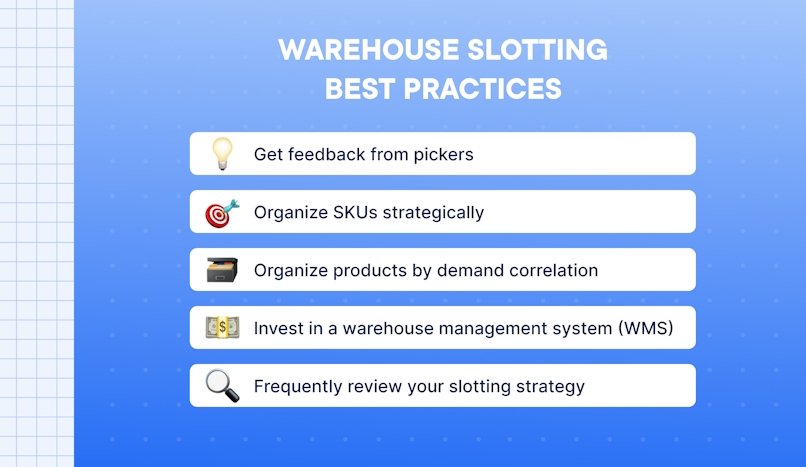Warehouse Slotting 101: Strategies, Best Practices, and Benefits
Warehouse slotting can make your warehouse operations more streamlined and cost-efficient. Here’s how it works.

Warehouse slotting is just one strategy for improving efficiency and saving money. Route optimization is another tool — and it’s made easy with Circuit for Teams.
If you run a delivery business, whether an eCommerce shop or a shipping company, you probably have a warehouse where you store your goods.
Warehouse slotting refers to how you organize your warehouse to make the most of the space and maximize efficiency.
For example, warehouse slotting makes it easier for pickers — the people who get items from the shelves to pack and ship — to find the specific goods they need.
Warehouse slotting is increasingly important as warehouses grow in size.
“Mega-warehouses” are becoming more popular, with the largest warehouse leases nearing seven-digit figures (931,860 square feet in 2022, up from 800,149 in 2021).
As retailers and wholesalers continue to expand their online stores, this trend is set to continue.
The problem with larger warehouses is that they are more difficult to organize and manage.
Warehouse slotting is the answer.
I go into greater detail about what warehouse slotting is and how it works, the benefits of warehouse slotting, and some warehouse slotting best practices.

What is warehouse slotting?
Warehouse slotting is the process of arranging inventory in a warehouse.
The goal of organizing inventory is to make it faster to “pick” goods (find and take them from shelves) and restock them.
Picture this: You’ve got a drawer full of silverware.
You decide to just dump all the silverware — soup spoons, teaspoons, big forks, dessert forks, steak knives, and butter knives — into the drawer.
When you need a soup spoon, you have to sort through your jumbled pile of silverware to find it.
But THEN you get one of those silverware organizers, which gives you separate slots for soup spoons, butter knives, dessert forks, and so on.
Now, when you need to find a soup spoon, it’s a lot faster, easier, and less stressful to locate.
Warehouse slotting is a lot like that silverware organizer.
With a warehouse slotting strategy, every item is assigned a specific place in the warehouse, making it easier to find and restock.

What are the benefits of effective warehouse slotting?
Warehouse slotting can help your business in a few ways. Here are some of the biggest benefits.
Saves warehouse space
Warehousing isn’t cheap.
Building a small warehouse of just 1,200 square feet can run some $25,000, while a 60,000-square-foot facility can cost as much as $1 million.
In short, it’s important to use your warehouse space wisely.
Warehouse slotting can help you optimize how you store goods and increase storage capacity.
The silverware drawer is a great example of this.
If you throw 50 forks haphazardly into a drawer, they’ll take up way more space than if you were to stack them on top of one another.
Similarly, if you have your warehouse goods crammed onto shelves or piled on top of one another, they’ll likely take up more space than if you sorted and organized them in an orderly fashion.
Faster picking time with fewer errors
One of the biggest jobs in a warehouse is “picking,” which is the process of locating and taking inventory from shelves.
People who do order picking may also handle packing — packaging the inventory and preparing it for shipment.
Pro tip: There are some best practices for choosing the right packaging for inventory.
If your inventory isn’t well organized, pickers can’t find it as easily — and the picking process takes longer.
Disorganization can also increase the risk of possible errors, like choosing the wrong item.
Pickers can also lose time if inventory isn’t organized correctly.
For example, it might make sense to place goods people frequently order together, like shampoo and conditioner, in the same area.
ECommerce giant Amazon is notorious for its seemingly “chaotic” warehouse practices — which are, in fact, designed to allow pickers to locate products as quickly as possible.
Take a product like mouthwash, for example.
You might think it makes sense to store all the mouthwash in one central place in the warehouse.
But if you go into an Amazon warehouse, you’ll find mouthwash shelves scattered all over the place.
Why?
It’s faster and easier for the picker to grab mouthwash from the nearest shelf, which might be ten feet away, than to walk a pick path across the entire warehouse to the ONE mouthwash shelf — which could be 1,000 feet away.
Reduces labor costs and other costs
Warehouse slotting can help cut costs in a few ways.
By maximizing your warehouse space, you’ll be able to use a smaller warehouse, saving money on renting, buying, or building an unnecessarily large facility.
A smaller warehouse also costs less to maintain, for example, in terms of basic utilities like air conditioning or lighting.
Additionally, warehouse slotting saves pickers time, which can help reduce labor costs.
Pickers are less efficient when they have to search for products.
Since it takes longer for them to finish their work, you may have to hire additional pickers to maintain everyday operations.

How to start using slotting in your business
Now that you know what benefits you can expect from warehouse slotting, you’re probably wondering: How do I actually do it?
I’ve got you covered.
Here are some steps you can try for using warehouse slotting in your business:
- Identify unused warehouse space. Macro slotting refers to how the entire warehouse or distribution center is laid out and organized. Start by identifying unused storage opportunities. For example, invest in higher shelves to maximize vertical storage space, which opens up more floor space. You might also consider details like the distance between shelving units — could shelving be moved closer together to create narrower aisles (and, again, free up floor space)?
- Figure out how to best order items together. Micro slotting focuses on the placement of individual items in the warehouse. For example, you want to place every stock-keeping unit (SKU) so pickers can grab it easily. Micro slotting also considers details like which containers hold SKUs.
- Sketch out your slotting strategy. Once you’ve come up with a plan for macro slotting and micro slotting, get it down on paper. Having a guideline to follow can make it easier to train warehouse workers, like pickers, on the new policies. Getting your slotting strategy down on paper can also make it easier to revisit the strategy down the line.

Warehouse slotting best practices
Whichever warehouse slotting strategy you choose, there are some basic best practices to consider. Keep the below tips in mind.
Get feedback from pickers
Pickers are on the front lines of product picking and replenishment.
So, they typically have the most well-informed feedback on how to address inefficiencies and improve workflows in your warehouse.
You might conduct a survey or focus group to get opinions from your pickers.
Organize SKUs strategically
There are a few ways to organize your SKUs (for example, by weight or cube size).
If items are generally moved in full cases or pallets (for example, by a forklift), it’s optimal to store them on racks — where they don’t take up valuable shelf space.
In contrast, products moved individually can be stored on shelves.
You can also use extra shelving to store items that come loose from the pallet packaging.
Organize products by demand correlation
One popular trick to guide slotting processes is to keep fast-moving product lines easily accessible.
Prioritize products that are in constant demand in the warehouse layout so they’re easy for pickers to access.
Consider using the “ABC slotting” approach:
- Pick a set time period, like 30 days.
- List all the SKUs fulfilled in that time period.
- Sort the list based on the number of line orders. Designate the top 50% of products (those with the most orders) as “A,” the next 25% as “B,” and the last 25% as “C.”
Seasonality can also affect demand and inventory management.
For example, Halloween decorations might sell more in late September and early October.
Invest in a warehouse management system (WMS)
You can simplify warehouse organization and warehouse operations using software products.
A warehouse management system (WMS) can help you manage inventory in real time, improving picking efficiency and reducing shipping errors.
For example, assign each product a unique scannable barcode.
Products are scanned into the WMS using a barcode.
Workers can then scan them at every point in the supply chain process, from picking to packing and shipment, for easy tracking.
Frequently review your slotting strategy
Your warehouse slotting needs may change with time.
For example, if you get a new product, you have to figure out where to slot it.
Visit your slotting strategy regularly to make sure it still meets your needs.
Again, this could start with your pickers.
Asking them for regular feedback helps keep your warehouse operations up to date.
Why slotting is important for your business
Having a warehouse slotting strategy takes time and effort. But it can benefit your business in many ways, including:
- Save warehouse space. This means you can store more inventory without paying for a larger warehouse. You can also save money on renting or buying a warehouse since you can fulfill your inventory storage needs with a smaller space. Plus, you can reduce overhead costs like lighting and air conditioning.
- Reduce picking time. A well-organized warehouse allows workers to find inventory faster and easier. This can also help cut labor costs since more efficient pickers can complete more work in less time, reducing the need for additional people power.
- Improve overall operational efficiency. With pickers working faster, you can complete order fulfillment quicker, getting goods to customers sooner. Learn more about the types of order fulfillment.
- Reduce the risk of lost inventory. Disorganization can also increase the risk of lost inventory if pickers don’t know where to grab and replenish goods. This also makes tracking inventory and calculating inventory turnover ratio easier (here’s how to do it).
All of this can add up to greater efficiency and cost savings — which makes warehouse slotting well worth your while.
This is just one of the ways to improve your warehouse’s material handling.
Final thoughts
By following warehouse slotting best practices, your business can benefit in many ways.
For example, you can maximize warehouse storage space and reduce operational costs, like labor.
Overall, slotting can also help improve your capacity planning.
But warehouse slotting is just one way to save time and money.
Another option for boosting efficiency is route optimization.
This is the process of optimizing routes for delivery drivers, giving them the fastest sequence of delivery stops.
Route optimization can help your drivers finish their routes faster.
By helping drivers avoid time-consuming hurdles like traffic jams and construction sites, you can save money — for example, on expenses like fuel.
But how does route optimization work?
Circuit for Teams makes it easy.
This software plans delivery routes for you.
Just add customer names and addresses and you’ll get fast delivery routes that consider real-world data like traffic conditions — and reduce travel time as a result.
Then, all you have to do is assign the routes to the right drivers.
It can even help improve driver performance.
Circuit for Teams also has other features that improve delivery efficiency, like the ability to set delivery time windows and give customers real-time delivery updates.





